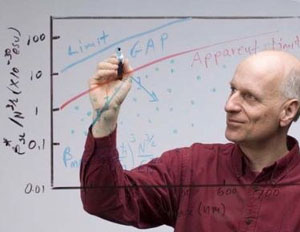New organic molecules that interact with light more strongly than any other materials could provide the template for new high-speed optical switches for telecommunications and data processing, according to an international team of researchers. The same compounds could also act as the basic units of optical memory systems and be used to produce high-density holograms.
Researchers from Washington State University (WSU), the University of Leuven in Belgium and the Chinese Academy of Sciences have developed and tested an entirely new class of chromophores. The chemists in China synthesised the compounds, which were then evaluated using theoretical calculations by scientists at WSU. The optical properties were then tested by the Belgian team. “To our great excitement, the molecules performed better than any other molecules ever measured,” says WSU physicist Mark Kuzyk.

Mark Kuzyk
Chromophoric materials that can modulate light became prominent in the 1970s with the advent of fibre-optic communications. For optical switching, data processing and putatively optical computing, materials that interact with light much more strongly are needed. In 1999, Kuzyk discovered a fundamental limit – now known as the Kuzyk limit – on just how strong that interaction could be. His research showed that all materials tested until then were at least thirty times weaker than the theoretical limit. This suggests that it might be possible to design and synthesise new materials with a lot more “optical brawn,” as Kuzyk calls it.
In 2006, Kuzyk and two WSU colleagues devised a new set of theoretical guidelines to describe the kinds of molecular structure that might fit the bill.

Molecular structure
Serendipitously, Clays was using his hyper-Rayleigh scattering technique to test seven different compounds sent to him by Yuxia Zhao at the Chinese Academy of Sciences. These compounds seemed to approach Kuzyk’s theoretical limit in terms of structural characteristics more closely than other materials. Physical tests by colleague Xavier Perez-Moreno then showed the compounds to have a more powerful interaction with light than any tested before.
We found an excellent agreement with Kuzyk’s theoretical results,” explains Perez-Moreno, “we wish to unveil the unifying principles behind the interaction of light and matter. The new design parameters revealed by the study suggest that a molecular structure in which the electron distribution can be distorted significantly, a structure with high “intrinsic hyperpolarizability”, in other words, would be most effective at modulating light, the basis of an optical switch.
Each of the new molecules has a chemical group at one end that donates an electron and one at the other that accepts an electron. In between is a molecular “bridge”. Previous efforts to boost the interaction with light focused on “smoothing out” the bridge to allow electrons to flow more easily from donor to acceptor end. Kuzyk’s calculations showed that instead of smoothing the bridge, it might work more effectively if it had a bumpy structure instead. These speed bumps on the molecular distort the molecules’ electronic structure. “Our calculations show that the more bumps, the better,” adds Kuzyk.
As such, he and his colleagues are looking to improve on even these record-breaking compounds. We have been thinking of ways to increase the degree of modulation, Kuzyk told Spotlight, The simplest approach is to make a longer bridge by adding more atoms or ring structures. However, the molecules tend to become more floppy, thus reducing the intrinsic hyperpolarizability. To overcome such problems, he suggests nanoengineering a tube that holds the longer molecule and straightens it out. The researchers have already carried out a large collaboration to do just that.
We have now shown that such a strategy works using an amylose helix as a rigid supporting tube, he revealed, and the intrinsic hyperpolarizability appears to also be a tad larger than previously measured molecules. One explanation of this small boost is that the helix itself may modulate the conjugation of the encapsulated molecule, potentially adding other possibilities to the toolkit.
I think that it will be more and more difficult to make better molecules, Kuzyk concedes, we may never be able to get to the limit. But, given all of the new techniques that are available to manipulate matter, such as nanotechnology, we may be able to get close.
Further reading
Optics Lett. 2007, 32, 59-61;
http://ol.osa.org/abstract.cfm?id=119888
Mark G. Kuzyk homepage
http://www.physics.wsu.edu/Personnel/faculty/kuzyk.html
Suggested searches
fibre optics